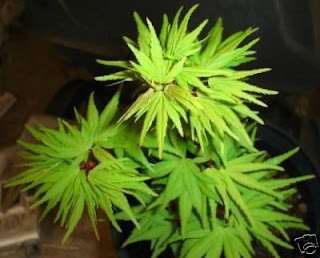I have been known to rant on about how people should try to include more native plants within their garden. However, I would never dissuade someone from including a Japanese maple within his or her garden; on the contrary, I would heartily recommend it.
History and colour
The image of a Japanese maple in full leaf brings to my mind images of oriental calmness, still water and moss covered mountains. This elegant plant is a distinct part of the culture and consciousness of its native Japan through its use in both horticulture and art. In the year 1800, over 200 varieties of this plant were noted in Japan, this figure grew over the next 100 years, only to have those numbers knocked back again to 200 by the maelstrom of the second world war. Japanese maples also known as Acer palmatum or Acer japonicum are diminutive in stature compared to other trees. Heights range from 1 metre to 7 metres, leading many gardeners to class them as large shrubs rather than small trees. Words cannot do justice to the colour displayed by a Japanese maple; it must be seen to be believed. An Acer owner will experience fiery new spring growth, calm summer foliage and even fierier autumn chilled leaves.
Palmate or Dissectum
There are two main groups of Japanese maple. The “Palmate” group has a reasonably upright growth habit with layered branches and leaves that are made up of five to nine lobes. The “Dissectum” group rightly lives up to its name with its lobed leaves dissected, feathered and lace-like. I feel that the maples in the “Dissectum” group look particularly well if planted close by an informal water feature due mainly to their weeping, cascading form.
How to grow a dwarf acer
Japanese maples do well if planted in an east facing aspect, allowing it access to the morning sun and protecting it from the mid-day sun. Shelter from winds and a moist but free draining soil are also important cultivation requirements. A 7cm layer of bark mulch applied to the plants base will help prevent the plant drying out. To enable good growth you must feed your little piece of the orient, apply a liquid fertiliser in mid-spring and again in mid-summer at half strength. As these Acers are shallow rooted, they are ideal for planting amongst other shrubs with no check to growth. For a delightful oriental scene, try planting Acer palmatum with rhododendrons, azalea, bamboo and birch.
Specimens for container growing
Two beautiful specimen maples whose leaves are opening out within garden centres now are “Orange Dream” and “Beni-Maiko”. “Orange Dream” is worth mentioning due to its fresh yellow/green lobed leaves. The young growing tips have an orange glow, providing an attractive contrast. “Beni-Maiko” on the other hand produces lovely pink foliage in spring turning to dark red in summer. Both of these Acers grow to around 1 metre tall, an ideal size for container growing. If you choose to grow a Japanese maple in a container, try to select one that is sympathetic to the plants heritage, a glazed oriental style pot would be ideal.




